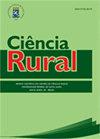巴西米纳斯吉拉斯州一家兽医医院周围野鸽中致病性和多重耐药细菌的鉴定和表征
IF 0.9
4区 农林科学
Q3 AGRONOMY
引用次数: 0
摘要
摘要:鸽子以其窝藏和传播几种人畜共患病原体的能力而闻名。研究表明,鸽子也是多药耐药菌株的相关传播者。在这项研究中,对一家兽医医院周围的鸽子进行了取样,并检测了致病性大肠杆菌、沙门氏菌、葡萄球菌和梭状芽胞杆菌的存在。从19只(40.4%)鸽子分离的大肠杆菌热稳定肠毒素1 (EAST1)编码基因检测呈阳性。肠致病性酶编码基因(eae)。1株(2.1%)检出大肠杆菌(EPEC)。在9只鸽子(19.1%)中检出沙门氏菌,均来自首次捕获事件(P < 000.1)。分别从6只和3只鸽子中分离到鼠伤寒沙门氏菌和海德堡沙门氏菌。沙门氏菌分离株的肠杆菌重复基因间一致性(ERIC-PCR)表明,9株菌株中有8株具有高度遗传相似性,支持了在这些鸽子中暴发沙门氏菌病的假设。从18只鸽子(38.3%)中分离出葡萄球菌20株(42.5%)。共检出8种,以木糖葡萄球菌(S. xylosus)最多。分离到艰难梭菌2株(4.3%)。鼠伤寒沙门氏菌、金黄色葡萄球菌和艰难梭菌各1株被分类为多重耐药菌株。目前的研究表明,生活在城市地区的鸽子可能是致病菌的宿主和传播者,包括医院病原体,如腹泻。大肠杆菌和耐多药葡萄球菌、艰难梭菌和沙门氏菌。本文章由计算机程序翻译,如有差异,请以英文原文为准。
Identification and characterization of pathogenic and multidrug-resistant bacteria in feral pigeons surrounding a veterinary hospital in Minas Gerais, Brazil
ABSTRACT: Pigeons are known for their capacity to harbor and spread several zoonotic agents. Studies have suggested that pigeons are also relevant disseminators of multidrug-resistant strains. In this study, pigeons surrounding a veterinary hospital were sampled and tested for the presence of pathogenic Escherichia coli, Salmonella spp., Staphylococcus spp., and Clostridioides (Clostridium) difficile. E. coli isolates from 19 (40.4%) pigeons tested positive for the E. coli heat-stable enterotoxin 1 (EAST1)-encoding gene. The intimin-encoding gene (eae) of enteropathogenicE. coli (EPEC) was found in one isolate (2.1%). Salmonella spp. were found in nine (19.1%) pigeons, all from the first capture event (P < 000.1). S. Typhimurium and S. Heidelberg were isolated from six and three pigeons, respectively. Enterobacterial repetitive intergenic consensus (ERIC-PCR) of the Salmonella spp. isolates suggested that eight of the nine strains had a high genetic similarity, supporting the hypothesis of an outbreak of salmonellosis in these pigeons. Twenty (42.5%) staphylococcal isolates were recovered from 18 (38.3%) pigeons. Eight different species were detected, with S. xylosus being the most frequent. Two (4.3%) C. difficile strains were isolated. Three isolates, one each of S. Typhimurium, S. aureus, and C. difficile, were classified as multidrug-resistant strains. The present research suggested that pigeons residing in urban areas can act as reservoirs and disseminators of pathogenic bacteria, including nosocomial pathogens, such as diarrheagenicE. coli and multidrug-resistant Staphylococcus spp., C. difficile, and Salmonella spp.
求助全文
通过发布文献求助,成功后即可免费获取论文全文。
去求助
来源期刊

Ciencia Rural
AGRONOMY-
CiteScore
1.70
自引率
0.00%
发文量
233
审稿时长
2-4 weeks
期刊介绍:
The purpose of Ciência Rural is to publish the results of original research, note and reviews which contribute significantly to knowledge in Agricultural Sciences. Preference will be given to original articles that develop news concepts or experimental approaches and are not merely repositories of scientific data. The decison of acceptance for publication lies with the Editors and is based on the recommendations of Editorial Comission, Area Committee and/ or ad hoc reviewers. The editors and reviewers are external to the institution.
 求助内容:
求助内容: 应助结果提醒方式:
应助结果提醒方式:


